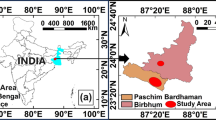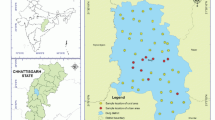Abstract
Background radiation can be different in both indoor and outdoor places. Background radiation is always in the environment, and all people in the community are constantly exposed to it. The most important source of exposure to gamma ray is natural radionuclides. Gamma rays can have harmful effects on the human body. The purpose of this study was to evaluate the health risk of gamma-ray exposure and to simulate using the Monte Carlo simulation. In this study, gamma-ray data were extracted from the studies carried out at intervals January 1, 2000, to December 31, 2018. Iranian and international databases were used to search for the articles. A total of 11 studies were found. To determine the health effects of gamma-ray radiation, the annual effective dose and excess lifetime cancer risk were calculated. To determine the uncertainty, a health risk assessment was conducted via Monte Carlo simulation. In outdoor, the mean, highest, and lowest absorbed dose of gamma ray were 117.82 nSv/h, 295.17 nSv/h, and 49 nSv/h, respectively. Ardabil Province and Chaharmahal and Bakhtiari Province have the highest and lowest gamma ray concentrations, respectively. In indoor, the mean, highest, and lowest absorbed dose of gamma ray were 118.22 nSv/h, 141 nSv/h, and 60.2 nSv/h, respectively. The last column, the mean, maximum, and minimum of excess lifetime cancer risk values for gamma-ray radiation were 2.45E−3, 4.17E−3, and 4.61E−4, respectively.



Similar content being viewed by others
References
Almgren, S. (2008). Studies on the gamma radiation environment in Sweden with special reference to 137Cs. Department of Physics; Institutionen för fysik.
Asere, A., & Ajayi, I. (2017). Estimation of outdoor gamma dose rates and lifetime cancer risk in Akoko Region, Ondo state, Southwestern Nigeria. Journal of Environmental Science, Toxicology and Food Technology,11, 49–52.
Asgharizadeh, F., Abbasi, A., Hochaghani, O., & Gooya, E. (2011). Natural radioactivity in granite stones used as building materials in Iran. Radiation Protection Dosimetry,149, 321–326.
Bahreyni, T. S., & Jomehzadeh, A. (2005). Comparison of environmental gamma radiation of kerman province and indoor gamma dose rate in kerman city using thermoluminescent dosimeter (TLD) and RDS-110. Medical Journal Of Hormozgan University, 9, 173–180.
Bahreyni, T. S., & Sadeghzade, A. A. (2000). Estimation of environmental gamma background radiation levels in Azarbayjan. Iranian Journal Of Basic Medical Sciences, 1, 1–7.
Bahreyni Toossi, M., & Yarahmadi, M. (2009). Comparison of indoor and outdoor dose rates from environmental gamma radiation in Kurdistan province. Journal of Kerman University of Medical Sciences,16, 255–262.
Basirjafari, S., Aghayari, S., Poorabas, S. M., Moladoust, H., & Asadinezhad, M. (2014). Assessment of outdoor gamma radiation dose rates in 49 cities of Guilan province, Iran. Iranian Journal of Medical Physics,11, 168–174.
Bouzarjomehri, F., & Ehrampoush, M. (2005). Gamma background radiation in Yazd province: A preliminary report. International Journal of Radiation Research,3, 17–20.
Eslami, A., Saghi, M. H., & Rastegar, A. (2016). Assessment of background gamma radiation and determination of excess lifetime cancer risk in Sabzevar City, Iran in 2014. Tehran University Medical Journal,73, 751–755.
Gholami, M., Mirzaei, S., & Jomehzadeh, A. (2011). Gamma background radiation measurement in Lorestan province, Iran. Iran Journal of Radiation Research,9, 89–93.
Hazrati, S., Baghi, A. N., Sadeghi, H., Barak, M., Zivari, S., & Rahimzadeh, S. (2012). Investigation of natural effective gamma dose rates case study: Ardebil Province in Iran. Iranian Journal of Environmental Health Science & Engineering,9, 1.
Iyogi, T., Ueda, S., Hisamatsu, Si, Kondo, K., Haruta, H., Katagiri, H., et al. (2002). Environmental gamma-ray dose rate in Aomori Prefecture, Japan. Health Physics,82, 521–526.
Jiang, Y., Zeng, X., Fan, X., Chao, S., Zhu, M., & Cao, H. (2015). Levels of arsenic pollution in daily foodstuffs and soils and its associated human health risk in a town in Jiangsu Province, China. Ecotoxicology and Environmental Safety,122, 198–204.
Kahani, M. M. M., Asl, A. K., Hashemi, S., Kahani, M. M., & Amini, M. (2016). Biological risk assessment resulting from terrestrial radionuclides in Iran. International Journal of Health System and Disaster Management,4, 88.
Kolo, M., Amin, Y., Khandaker, M., & Abdullah, W. (2017). Radionuclide concentrations and excess lifetime cancer risk due to gamma radioactivity in tailing enriched soil around Maiganga coal mine, Northeast Nigeria. International Journal of Radiation Research,15, 71.
Koupaie, E. H., & Eskicioglu, C. (2015). Health risk assessment of heavy metals through the consumption of food crops fertilized by biosolids: A probabilistic-based analysis. Journal of Hazardous Materials,300, 855–865.
Kumar, A., & Xagoraraki, I. (2010). Human health risk assessment of pharmaceuticals in water: An uncertainty analysis for meprobamate, carbamazepine, and phenytoin. Regulatory Toxicology and Pharmacology,57, 146–156.
Mesdaghinia, A., Nasseri, S., & Hadi, M. (2016). Assessment of carcinogenic risk and non-carcinogenic hazard quotient of chromium in bottled drinking waters in Iran. Iranian Journal of Health and Environment,9, 347–358.
Miri, M., Bhatnagar, A., Mahdavi, Y., Basiri, L., Nakhaei, A., Khosravi, R., et al. (2018). Probabilistic risk assessment of exposure to fluoride in most consumed brands of tea in the Middle East. Food and Chemical Toxicology,115, 267–272.
Mjönes, L. (1986). Gamma radiation in Swedish dwellings. Radiation Protection Dosimetry,15, 131–140.
Moeller, D. W., & Sun, L.-S. C. (2006). Comparison of natural background dose rates for residents of the Amargosa Valley, NV, to those in Leadville, CO, and the states of Colorado and Nevada. Health Physics,91, 338–353.
Monica, S., Prasad, A. V., Soniya, S., & Jojo, P. (2016). Estimation of indoor and outdoor effective doses and lifetime cancer risk from gamma dose rates along the coastal regions of Kollam district, Kerala. Radiation Protection and Environment,39, 38.
Pashazadeh, A. M., Aghajani, M., Nabipour, I., & Assadi, M. (2014). Annual effective dose from environmental gamma radiation in Bushehr city. Journal of Environmental Health Science and Engineering,12, 4.
Qu, C., Sun, K., Wang, S., Huang, L., & Bi, J. (2012). Monte carlo simulation-based health risk assessment of heavy metal soil pollution: A case study in the Qixia mining area, China. Human and Ecological Risk Assessment: An International Journal,18, 733–750.
Radiation, UNSCotEoA. (2000). Sources and effects of ionizing radiation: Sources. United Nations Publications.
Rajasekhar, B., Nambi, I. M., & Govindarajan, S. K. (2018). Human health risk assessment of ground water contaminated with petroleum PAHs using Monte Carlo simulations: A case study of an Indian metropolitan city. Journal of Environmental Management,205, 183–191.
Ramli, A. T., Sahrone, S., & Wagiran, H. (2005). Terrestrial gamma radiation dose study to determine the baseline for environmental radiological health practices in Melaka state, Malaysia. Journal of Radiological Protection,25, 435.
Saghatchi, F., Salouti, M., & Eslami, A. (2008). Assessment of annual effective dose due to natural gamma radiation in Zanjan (Iran). Radiation Protection Dosimetry,132, 346–349.
Saha, N., Rahman, M. S., Ahmed, M. B., Zhou, J. L., Ngo, H. H., & Guo, W. (2017). Industrial metal pollution in water and probabilistic assessment of human health risk. Journal of Environmental Management,185, 70–78.
Shahbazi-Gahrouei, D. (2003). Annual background radiation in Chaharmahal and Bakhtiari province. Iranian Journal of Radiation Research (Print),1, 87–91.
Shahrbabki, P. E., Hajimohammadi, B., Shoeibi, S., Elmi, M., Yousefzadeh, A., Conti, G. O., et al. (2018). Probabilistic non-carcinogenic and carcinogenic risk assessments (Monte Carlo simulation method) of the measured acrylamide content in Tah-dig using QuEChERS extraction and UHPLC-MS/MS. Food and Chemical Toxicology,118, 361–370.
Sharma, P., Meher, P. K., & Mishra, K. P. (2014). Terrestrial gamma radiation dose measurement and health hazard along river Alaknanda and Ganges in India. Journal of Radiation Research and Applied Sciences,7, 595–600.
Taskin, H., Karavus, M., Ay, P., Topuzoglu, A., Hidiroglu, S., & Karahan, G. (2009). Radionuclide concentrations in soil and lifetime cancer risk due to gamma radioactivity in Kirklareli, Turkey. Journal of Environmental Radioactivity,100, 49–53.
Tavakoli, M. B. (2003). Annual radiation background in the City of Isfahan. Medical Science Monitor,9, PH7–PH10.
Acknowledgements
The authors of this work thank the Lorestan University of Medical Sciences (LUMS) for supporting this project and the students involved in conducting the experiments.
Author information
Authors and Affiliations
Corresponding author
Additional information
Publisher's Note
Springer Nature remains neutral with regard to jurisdictional claims in published maps and institutional affiliations.
Rights and permissions
About this article
Cite this article
Saghi, M.H., Mohammadi, A.A., Ghaderpoori, M. et al. Estimate the effective dose of gamma radiation in Iran cities: lifetime cancer risk by Monte Carlo simulation model. Environ Geochem Health 41, 2549–2558 (2019). https://doi.org/10.1007/s10653-019-00300-y
Received:
Accepted:
Published:
Issue Date:
DOI: https://doi.org/10.1007/s10653-019-00300-y




